
Email - Graeme@protectiveshoeing.com
Protective Shoeing,
What it is, and how it can protect your horse
PRICE INCREASE JULY 2022 See prices page
I GUARANTEE ALL HORSES FOOT SOUNDNESS
SHOES WILL STAY ON CRACKS WILL HEAL AND YOU CAN RIDE
Does your horse have cracked feet? Odd weird unexplained lameness? I guarantee foot soundness! How is that possible? It is! You don't believe me?
Read on.... Challenge me, if you like... got a horse that won't be sound? Won't keep shoes on? Give me 3 shoeings.
IF YOUR HORSE ISN'T FOOT SOUND BY THEN, I'LL REFUND ALL YOUR MONEY.
(You must abide by the terms and conditions on this site, and prior veterinary conditions will be taken into account and discretion used, but won't necessarily invalidate your refund)
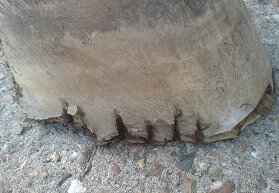
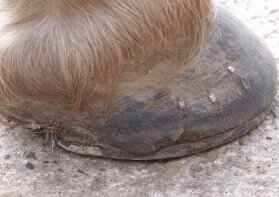
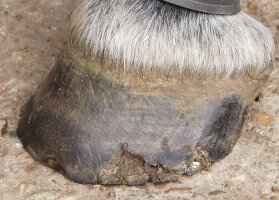
Maybe shoes are always coming loose or being lost, like those pictured here on the first day I saw these horses feet. All were restored to regular working.
Most of this damage is caused by the influence of the shoes on the feet, but it needn't be, and it can be stopped!
Some horses cannot cope with barefoot and need shoes, but find after a while, then they have problems because of the shoes.
This paradox is because shoes actually encourage damage from their first day on the feet, by trapping mud, moisture and bacteria constantly under them, softening and infecting areas under the shoes, bacteria that slowly, constantly, eat away at the supporting horn, eventually destroying the hoof wall in some horses, when the shoes then come off.
Want to tell if your horse's feet are collapsing or crushing? That's easy. If the clenches are rising, your horse's foot is collapsing.
Nails are driven upwards through the wall by the same amount as the foot is collapsing.
Mud under the shoes is abrasive, it is paste - containing little sharp particles immersed in water, which with every step, is driven forcibly by the shoe into the softened horn above it, day after day, week after week, stride after stride. Mud beneath the shoes holds moisture and bacteria which weaken the wall's ability to carry weight and encourage infection to damage the white line and adjoining wall, causing collapse and discomfort.
The shoes can no longer provide correct support, they constantly move, working loose, shifting position and changing balances, they can put pressure in vulnerable areas where it is not desired, and they can be trodden on and lost, tearing off large chunks of damaged wall in the process.
Protective Shoeing eliminates the damaging conditions shoes create and gives loads of extra support, stopping collapse, especially at the heels where stresses and concussion are greatest.
It protects growth of healthy horn while the shoes are on, stopping infection and mud damage, and keeping you riding.
It enables the foot itself to do the job nature intended, that of protecting the inside sensitive structures which then results in the horses gaining far more confidence, and a much more comfortable action.
Protective Shoeing means putting a modern low melt point plastic between the shoe and the foot which stops mud getting in.
The plastic is the same hardness and flexibility as the horn, with very similar properties. To your horse, it just feels like a very comfortable part of his own hoof.
It is so safe I do not need to wear gloves, meaning I can mould it to a perfect fit while I work, with my fingers.
IT'S NOT GLUE. I DO NOT USE GLUE, except in very, very rare cases.
Acrylic glues and polyurethane glues such as those used by farriers contain solvents that carry serious health warnings.
THIS PLASTIC CONTAINS NO SOLVENT, it's scientifially designed to melt at 60 degrees, hot water temperature.
It's warm and only has to cool to set. There is NO solvent, so NO fumes or chemicals in the air.
It is exactly the same plastic as used in 'Imprint' shoes, designed primarily for horses with laminitis and sports horses.
It doesn't inhibit flexion, it is concussion absorbing, weight bearing, and resilient.
It can be used alongside any kind of shoe, hoof cast or pad, or moulded alone, to fit.
The plastic is heated with nothing more dangerous than hot water, using the waste heat from the forge.
A simple portable manual injector sytem is used to deliver the plastic prior to the shoes being nailed on.
2 nails are used to locate the shoe properly. The horse is then encouraged to compress the plastic by standing on it while it is still a liquid.
That has the effect of completely levelling the plastic across as wide an area as possible, sealing all the gaps and spreading the weight bearing - in a lot of cases it actually DOUBLES the load area, which HALVES the stresses. That means only HALF the concussion - instantly.
The plastic is then moulded by hand, the excess removed, and the remaining nails are put in.
Its like your horse having a pad that fits each foot perfectly, a mirror image of support that protects their feet from the ingress of dirt, bacteria and infection.
This means more healthy horn grows than is damaged, and the feet will actually repair themselves naturally by growing during each shoeing cycle without more damage.
Feet don't shatter, clenches don't rise, the wall and heels don't collapse, and shoes don't come loose.
The old damage is removed at the next shoeing and replaced with new healthy horn, which increases the strength and capability of the foot itself, more each time.
Each shoeing increases strength, unlike unprotected shoes which can decrease strength each time, by constantly allowing mud in to weaken, infect and saturate the foot.
The amount of abscesses and lamenesses reduce dramatically because the hoof is now able to protect and support properly, and grow without further damage.
Want to go barefoot?
The disadvantage of barefoot is initially exposing soft already damaged formally shod feet to the harshness of rocky uneven terrain. Many horses struggle with that.
Protective Shoeing eliminates a 'barefoot induction period'. Feet repair as the horse keeps working, naturally, by growth, as nature intended.
Subsequently you can go barefoot when the feet are strong and healthy, if that is your aim.
Since 2006 when I introduced this method, there was an INSTANT 80% decrease in abscesses, and 95% decrease in lost shoes.
Shoeing periods have increased from 4 or 6 weeks to 8 weeks average, meaning it is more cost effective. It is not more expensive.
THATS PROVEN AND ITS GUARANTEED. I GUARANTEE SHOES WILL STAY ON FOR 6 WEEKS (Terms apply, click on that link).
You can ride immediately after shoeing, go competing, turn him out, whatever. Competing horses that need to be kept fit are not laid off through unexplained lameness. Thermoplastic is resilient enough to support and withstand competition, field mud, riding of any description, without displacement, for six weeks and more.
All of the feet pictured above were totally repaired, rebalanced and rebuilt with Protective Shoeing.
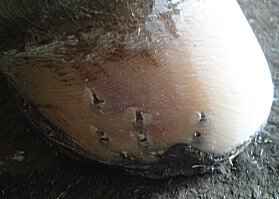
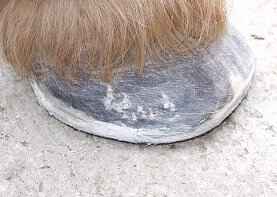
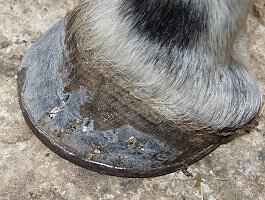
Yes these are the same feet as those above, the same horses, just a few months later. Protect them from damage and healthy growth will return,
as will balance, support and confidence, without the need to go barefoot or have special shoes.
The advantages of barefoot coupled with the advantages of shoeing, with the drawbacks of both minimised.
Hi, my name is Graeme, I am a registered farrier of 35 years experience working in South East England.
Welcome to my website.
As a working farrier I have always questioned why most horses feet deteriorate with shoes on, despite the fact that the shoes were comfortable and the feet carefully balanced on the day the shoes were applied.
Such questions have led me to conduct a study of how horseshoes can actually harm horses feet, and how they can easily encourage what I call natural hoof destruction, how that hoof destruction works, why, and how to help prevent it, ultimately leading to the creation of this website, which I hope will help both farriers and horseowners alike.
Veterinary and farriery industry professionals all agree that one of the primary reasons for lameness in horses is deformation of the hoof capsule, and primarily stretching and twisting of the hoof wall, resulting in unbalanced stresses being transmitted to the bones within and above the hoof.
The majority of those professionals are agreed on the need for rebalancing to aid the recovery of hoof position to the proper functions, however, there has been almost nothing written about the ways in which the hoof wall becomes imbalanced, damaged or stretched in the first place. Surely prevention is better than cure?
Horses are not born with infected or broken up feet, stretched toes or collapsed heels, so why do they become so?
Very little is written about the response of horn to its environment which is in my opinion the primary cause of horn destruction. Even less is written about preventing the horn becoming stretched, twisted, damaged or deformed in the first place. The phrase "Your horse just has bad feet. Theres nothing I can do about it" is the most frustrating and incorrect statement I have heard. "Surely it is part of the farrier's job to do something about bad feet", is my response.
Horseshoeing plays its part in the problem
The problem with all horseshoes is that they have an in-built design flaw that barefooters feet don't have.
This is why, of late, many horseowners have become disillusioned with farriery, and opted to leave their horses barefoot.
A lot of horses are better off barefoot, in my experience, around 60% of them. But sometimes barefoot doesn't protect enough, especially in wet conditions,
or if the horse is competing at speed and across difficult terrain, or has particularly sensitive or vulnerable feet.
I have found, in my study of the destruction of the horses hoof, and why it happens, that the most important aspect to horseshoeing is the environment horseshoes create in the vulnerable areas of the white line and underwall between the shoe and the foot.
To put it simply, this is the area beneath the shoes, which horseowners cannot get at, and consequently you cannot keep it clean.
Mud, dirt, faeces, urine and festering wet quickly gets under the shoes, usually on the first day the horse is shod, when he goes into the field. and because there is no air circulation, and sunlight cannot get in, it remains there throughout the whole period of the shoeing.
The horn that your horse's feet are made from is an organic material. It absorbs wet. All organic materials can be damaged and destroyed by poor environments.
All organic materials have three distinct phases. There's creation, a phase of useful life, then destruction. All are necessary.
The problem with horses feet is that the destructive phase is sometimes accelerated to the point where it happens much too soon.
To put it simply, creation happens at the top of the foot and works its way down, but destruction comes from the bottom and works it way up - but if destruction accelerates beyond the lowest point of the sensitive structures or blood line, then a lame horse is the result.
Protective Shoeing is a way of ensuring that this does not happen, and the area under the shoes stays clean, healthy and supported.
The problem with shoes is that they create a situation where two mating surfaces, the shoe and the foot, marry closely.
I hear most people say "thats how it should be", and that is true, but when two surfaces mate together closely it encourages a natural phenomenon called capillary action, between them.
I wont bore you with the science, but capillary action is a way that water is easily drawn into a very narrow space. The water "sticks" to both sides of the space, forming a water "bridge" between the surfaces. Water has a property which attracts it into such narrow gaps - and holds it there.
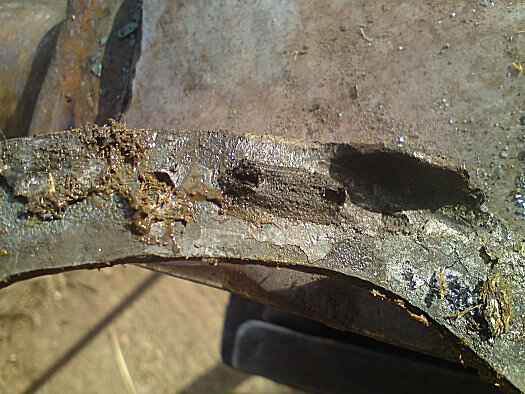 |
This
photograph shows a shoe that has only just been taken off of the foot.
This is the surface of the shoe that is against the foot, and we can
see the moisture, mud and dirt that the capillary action has drawn in.
This horse has been standing in this septic combination throughout the
period
of the shoeing, and the area beneath this shoe was completely blackened
with infection. Dont forget the horn is an organic substance, edible to certain organisms. Ask most dogs, they love eating it! It is therefore unsurprising to me that the horses feet suffer infections when they are constantly subjected to these conditions. What makes this illustration so stark in its reality is that this particular horse had been on box rest for some weeks, meaning this mud had penetrated and lasted that time. Just try putting mud and poo in your wellies and wearing them for six weeks at a time.....you get my drift. |
It is by capillary action that tissue paper can draw water up into it on contact, even if the paper is out of and above the water. The fibres of the tissue paper are close together but have narrow gaps between them which attract the water to stick to them, forming bridges between them and "sucking up" the water, and also any dirt or bacteria in the water. The gap between horses shoes and their feet is narrow and behaves in exactly the same way, "sucking in" the water, and any dirt or bacteria in it. This happens to all horses that have shoes on - except those with protection against it.
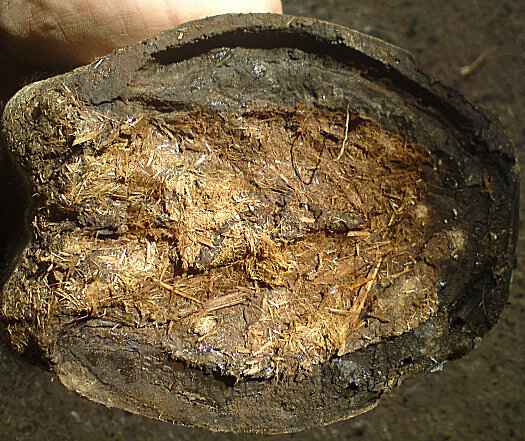 |
And
this is the foot that shoe came from. I deliberately did not clean this foot before I took the shoe off as I wanted to demonstrate to the owner of this horse who was not present, the appalling stable management that he was being subjected to. As he was in the stable constantly, good management is vital. Rubber beds are a great idea for horses but this picture demonstrates that it is very important when they are on them that adequate bedding should be used to completely protect the feet from infection and standing in faeces constantly. Rubber has the drawback that it is waterproof, and urine and faeces will sit on top of it if bedding and drainage are inadequate. Where the horse stands his feet will create indents in the rubber into which moisture will run. The result is that he will constantly have his feet in liquid manure, as you can see this horse did. |
Capillary action creates the perfect situation for moisture, mud and to be compressed in between the horseshoe and the foot which then becomes trapped there. Sunlight cannot get in, and there is little air circulation, so unlike bare feet, the feet remain constantly waterlogged and never dry, or at least, not until the farrier removes the shoes - after the destruction and damage has already occured.
It is as if the horse is standing constantly in a wet muddy puddle throughout the shoeing period, which encourages softening, stretching of the toe, expansion of the sides and collapse of the heels, and destructive bacteria to get up into sensitive areas causing lameness. Once warmer conditions arrive, like a sunny day, or spring weather, it warms the whole foot, creating wet and warm conditions beneath the shoe and inside the underwall - perfect for bacteria to multiply massively, and eat rapidly away at the strength, cohesion and support the horn is supposed to offer.
There are areas underneath the shoes where there are gaps, as the shoes are generally far wider than the wall they support.
These gaps rapidly fill with wet mud which encourages moisture and bacteria to destroy the horn surrounding them, and especially the horn where the nails are - the nails will conduct the moisture and bacteria up in to the underwall, where there is plenty of healthy nutritious horn to eat. Ask your dog, he probably loves it!
It is very important that these weakening forces are minimised, and Protective Shoeing, along with careful management, keeps this destruction to an absolute minimum. The objective is to encourage more healthy horn to grow than is being destroyed which keeps your horse comfortable, sound and hopefully out of the clutches of the vet!
So join me while I try to explain how and why Protective Shoeing works, and simple precautions you as a horse owner can take to help your horse protect himself from discomfort and the horrible things pictured above!
© Graeme Burt DWCF